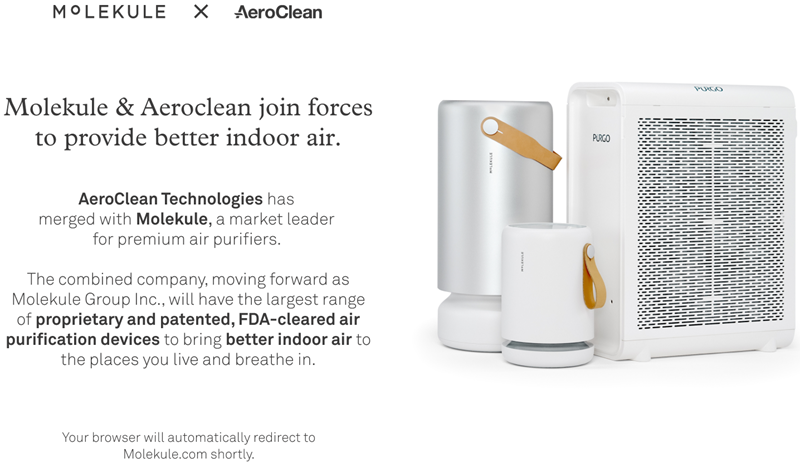Long-term health benefits of cleaner and safer air for US schools can be realized with AeroClean Safe Air Technology
The effects of the global pandemic continue to impact our everyday lives, and the conversation around improved indoor air quality (IAQ) continues to escalate. According to the EPA, most experts and scientists say Americans, on average, spend approximately 90% of their time indoors, where the concentrations of some pollutants are often 2 to 5 times higher than typical outdoor concentrations.
Despite this data, educational institutions still have the impetus to return students to in-person learning following the lower student test scores, security issues, and general Zoom fatigue that came to the surface throughout the pandemic. Taking into account that students and educators not only spend long durations of time together indoors – they also spend them in proximity to one another – increasing the opportunity to spread infections. Thus, now more than ever, there is a demand for a longer-term solution for safer, cleaner working spaces that go beyond surface and hand sanitation. In response, programs like the Emergency Elementary and Secondary School Relief (ESSER) Fund, a primary component of the American Rescue plan (ARP), were announced by the DOE to assist schools in improving their indoor air quality (IAQ) in 2020 as students returned to the classroom. The ESSER funds can be applied for clean air technologies so educators, staff, students, parents, and the entire community can feel more comfortable knowing that cleaner, safer air will be available in the indoor spaces of the schools and their facilities. However, many of these funds are not being spent and time is running out.
U.S. Secretary of Education Miguel Cardona urges states to deploy the fund given the impact of the pandemic, stating that “In areas where these funds are being deployed quickly, we are already seeing the positive impact that this infusion of federal support is having directly in schools and communities. We know what it takes to keep our schools open safely for in-person learning, and these funds will help us achieve that goal.”
The White House also published helpful guidelines and a call to action for business owners, building operators, and schools to improve ventilation in their facilities and reduce the spread of COVID-19. Cleaner indoor air quality – which can be achieved by improving the ventilation, strengthening air filtration, and disinfecting the air – “will not only improve health and well-being now, it is an investment that will benefit future generations and improve people’s long-term health,” said Dr. Alondra Nelson, head of the White House Office of Science and Technology Policy and Deputy Assistant to the President. In this same discussion with Dr. Nelson, Mary Wall, the Senior Policy Advisor for the White House COVID response team, also stated regarding the Clean Air in Buildings challenge, that, the plan is focused on a couple of core activities – “one is protecting against COVID-19, number two is preparing for new variants, and number three is preventing economic and educational shutdowns and on the last piece we are really focused on indoor air quality.”
Many aspects contribute to poor air quality – harmful pathogens such as viruses; bacteria, fungi, mold, allergens, pollutants, and chemicals (VOCs). Ventilation can help address these concerns, but traditional HVAC does not address all these airborne threats. HVAC upgrades are costly, take planning, and in some older buildings are not feasible. The use of energy also skyrockets and drives higher costs and strain on organizations which inhibits facility managers from becoming more green, so supplemental, sustainable solutions look to be the best way forward.
“We need to start thinking of IAQ like how we think of our drinking water – that it is essential to our health and well-being, and we need to do what we can to improve IAQ and eliminate airborne threats in our everyday environments. Our students, educators, and staff could immediately benefit from improved IAQ, and we look forward to seeing these benefits manifest as more schools deploy air filtration, ventilation, and sanitization programs. Everyone can benefit from improved IAQ.” said Jason DiBona, CEO of AeroClean.
Moreover, in a recent study led by a team of experts affiliated with Dr. Joseph Allen’s Healthy Buildings program, the findings cite that “ the effects of PM2.5 are not exclusive to children or older populations, but are also present among young adults”. The study takeaways cite that “findings provide further incentive to improve air quality in indoor spaces”, and that “higher ventilation rates and enhanced filtration that exceed current minimum targets are important public health strategies, and we must pursue them.” Additional to educational facilities, IAQ should be monitored for those in the workforce returning to the office or in any indoor space.
AeroClean is a pathogen elimination technology company with Pūrgo™ (pure-go), an FDA 510(k) cleared, Class II medical device that provides continuous air filtration, sanitization and supplemental ventilation with technology that can be applied in any indoor space, like in schools and educational facilities, and its solution deploys the strategies laid out by the following federal guidelines to prevent further spread of COVID-19. Pūrgo™ products feature SteriDuct™, a proprietary germicidal technology developed by best-in-class aerospace engineers, medical scientists and innovators that work to eradicate viral, fungal, and bacterial airborne microorganisms. With simply plug-and-play installation, the Pūrgo™ only requires 120 VAC 60 Hz (grounded) energy use to power on and requires minimal operation maintenance. Pūrgo™ is also effective at reducing the viral concentration of the Omicron variant of SARS-CoV-2, the virus that causes COVID-19, which the CDC identifies as the current dominant variant in the United States.
Learn more about how you can partner with AeroClean to address IAQ concerns with Elementary and Secondary School Relief Funds (ESSER) by sending an email directly to info@aeroclean.com or by visiting AeroClean’s website.
Contributors: Jimmy Thompson, Lydia Young
